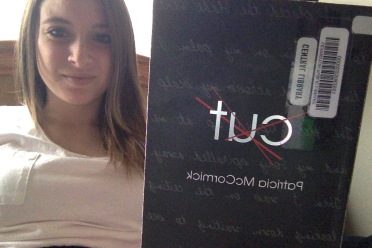Week 11, Cut by Patricia McCormick
McCormick, P. (2000). Cut. Asheville, NC: Front Street.
Summary:

Currently in deep thought after finishing this book!
At first, it seems as though Callie is a normal teenager with a normal set of parents and a normal younger brother. But soon, it becomes apparent that Callie’s life is not normal. Instead, Callie’s family has their own troubles and Callie has a threatening secret of her own. She cuts herself. When a school nurse sees the scars on Callie’s arm, she is sent to a residential treatment facility called Sea Pines, nicknamed by the residents as “Sick Mind”. Callie meets a variety of girls like herself, some with substance abuse problems and others with eating disorders. None are girls that Callie really opens up to, and nobody knows why. One day, she does, and soon she reveals why she engages in the act of cutting. Follow along as Callie discovers her internal struggles and learns that she has to play a part in her own healing
Keywords: high school; rehab; self-mutilation; recovery; internal struggle
What I Think:
This book, although covering a very heavy topic, did a phenomenal job of trying to give the reader the perspective of a young high school teenager with the unnerving urge to cut herself. I would recommend this book for a young adult library collection because of the descriptive glimpse it gives into the life of a teenage girl with a clear mental illness stemming from obvious family and internal struggles. This book truly attempts to give understanding to those who may not have gone through such struggles but also gives those who have gone through such struggles an admirable character to which they can relate. Either way, the book does an excellent job of emulating how the main character feels in a relatable way as she goes through her struggles and triumphs. “Tears, warm and sudden, sting the corners of my eyes, but I don’t cry. Sam cries. My mom cries. I don’t cry” (McCormick, 2000, p. 42). This quote demonstrates a moment that the audience can relate to, even though Callie is in the situation of having to take sleeping pills in the rehab facility, it is a feeling that many people have experienced and can therefore make the connection to the character.
What the Experts Think:
Sea Pines, a.k.a. Sick Minds, treats teenaged girls with food- and substance-abuse issues, and Callie, whose issue is self-mutilation. She will not talk about her dysfunctional family, her guilt toward her brother Sam’s severe asthma, or why she cuts herself. She will not talk—period. Cut is Callie’s interior monologue that alternates between her interactions with her therapist and her interactions with the other residents, the staff, and her family. Her thought process reveals a girl who seems to have given up on life until one cut scares the life back into her. The ability to talk then becomes a metaphor for Callie’s ability to understand herself and to begin the healing process. Readers are also treated to the downfalls and triumphs of Callie’s peers, including a new resident who shares Callie’s affliction. First-timer McCormick tackles a side of mental illness that is rarely seen in young-adult literature in a believable and sensitive manner. Unlike other authors of this genre, she avoids stereotypes and blends gentle humor with this serious topic. McCormick ultimately portrays Callie as a normal teenager who yearns for a stable family structure and friends, and who also has a psychological problem. A thoughtful look at teenage mental illness and recovery. (Fiction. 13-15)
This book would be a great one to just have in the classroom library for students to read if they choose. As a teacher, I would use this book as a choice for students who may be struggling with different mental health issues or simply seem to be struggling more than usual with high school issues.
This book would also be great to use with a specific group of students that are known to have mental health struggles, such as those who have eating disorders or are engaging in substance abuse. I would use this book to spark discussion among this group of students and facilitate a sense of connection community among the group.This will hopefully allow for the group to be supportive to the specific group of teenagers that need that support. I would also have this group that read and discussed the book to write a piece about what he or she would have done differently at different points in the book if they were in Callie’s shoes. This would allow for the group of students to express their opinions on how they would’ve handled these tough situations and will hopefully allow them to come to safe solutions to these problems.